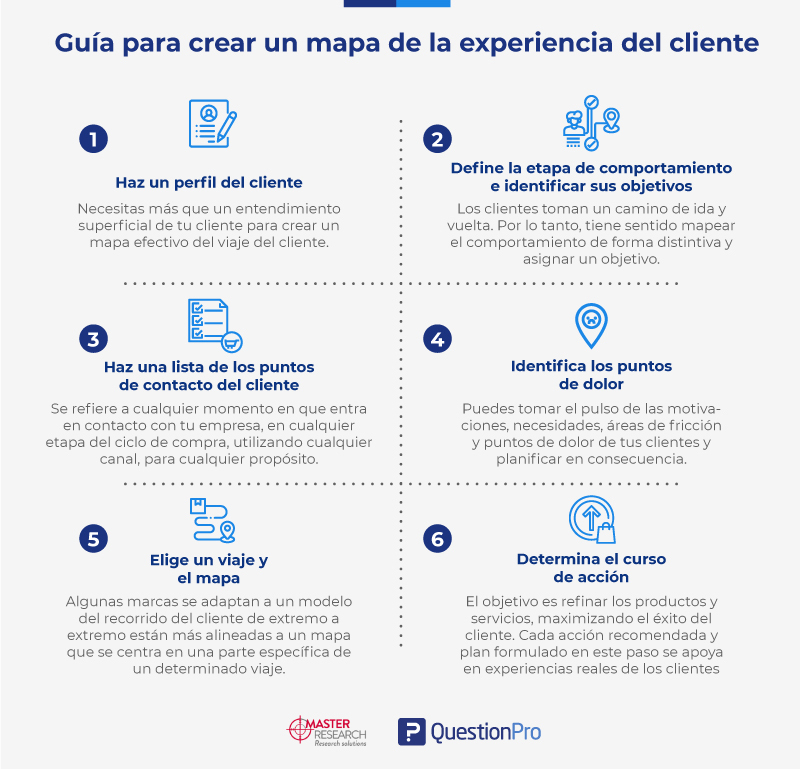6 steps to creating an effective customer journey

We have the steps for you to create an effective customer journey and ensure that you are creating an incredible experience for your customers at each point of contact with your brand. Read on and find out how to do it!
Customers are leaving brands faster than they used to, as trends indicate. They lose interest halfway through, much earlier than organizations expect them to.
This abrupt loss of interest in a product / service is fueled by increased awareness and higher expectations that customers have, thanks to available online resources and the influence of social media. Today’s consumers know they have options and are not averse to trying until they find the brand of their dreams.
That said, customer experience is the only differentiator that can convince an informed customer to stick with a brand.
What is the customer journey?
The customer journey is the summary of everything that the customer experiences in their relationship with a company from beginning to end. This journey begins with the first contact that customers have with your company, and the goal is (always) to create a long-term relationship.
However, it is not an easy goal, so the main goal of the customer journey is to try to understand what works and what does not. Gather knowledge, foster a shared customer-centric vision across the organization, and understand how to best meet customer needs.
Benefits of designing an effective customer journey
A business needs to manage the customer journey from the beginning. They can create a map as soon as they can get some consumer data to do some research. Mapping the customer journey requires more than intuitions and hunches, as robust data and behavioral analysis should support it.
Before addressing the steps to create a customer journey, we have for you the benefits of doing this process:
- Creating a customer journey is a unique opportunity for companies to get inside their customers’ heads and gain valuable insights into how a brand is perceived.
- They inspire empathy in employees, and they will gain clarity about what buyers want and how they often feel in the process.
- With proper understanding and clear metrics, you can master customer behavior patterns and obstacles, equipping yourself to develop best practices and anticipate future needs.
Steps to create a customer journey
Next, we have for you a guide with the steps to create a customer journey that will exceed customer expectations.

Step 1: Create a customer profile
Understanding the customer journey begins with identifying your buyer. How is your client? You may think that you know your customers and their needs, but how well do you do it?
You need more than a cursory understanding of your customer to create an effective customer journey map. Ask your clients what you need to know and they will fill in the blanks for you.
The online surveys are a great way to do it. From the Net Promoter Score and the Customer Satisfaction Indicator to the Customer Effort Score, there are numerous ways to collect customer information and better understand them.
In addition, the data will help you discover how they got to know you, what prompted them to select your product / service, and what obstacles they faced on their journey.
Once you’ve collected the necessary data, you can create a fictitious customer profile to represent your ideal customer.
It is not necessary to cram the characteristics of several people into a single buyer person. You can have multiple buyers, representing diverse client bases.
What the heck is the NPS? And how to know if your potential customers don’t like you.
Step 2: Define the behavioral stage and identify your goals
Another step to creating an effective customer journey is discovering how customers learned about your brand.
There are 5 distinct phases your prospect goes through: Awareness, Consideration, Purchase, Retention, and Advocacy.
While most clients go through all of these phases in one way or another, it cannot be represented on a linear journey from A to B.
Most often, customers take a roundtrip, mixed, cyclical, or multi-channel path to get to the end point. So it makes sense to map behavior distinctively for each of these broader phases and assign a goal for each phase.
If you’re creating your first customer experience map , a smart approach is to pick the common customer and chart the route they would typically take the first time they come into contact with your brand.
It is vital that your touchpoints have a purpose and determine if customers are achieving their goals by going down this route.
Step 3: Make a list of customer touch points
If you don’t know what your customer’s journey with your company is like, how can you hope to optimize it?
Touchpoints are all the places where your customers can interact with you. It refers to any time they come into contact with your company, at any stage of the buying cycle, using any channel, for any purpose.
It is nothing more than an end-to-end map of the entire customer journey, from the first point of contact to the last.
The objective of this exercise is to analyze if you are reaching the goals that have been established for them in each phase and to optimize these points to have a better performance.
Not all touchpoints need to be treated the same, as some have a more decisive impact than others. You also can’t afford to completely ignore any touch points, as they are all opportunities to listen to customers and can be leveraged to make the process easier and smoother.
Take care of your client as yourself !
Step 4: Identify pain points
Do you know that every point of contact can become a point of pain if not carefully considered? When tracing them, it is inevitable that you will come across potholes and obstacles.
This is one of the steps to create a more important customer journey, it is the backbone of creating a journey map to improve the customer experience, solve these problems and fix the potholes that customers usually find in their trip.
The customer journey map allows you to be prepared and be proactive. You can take the pulse of your clients’ motivations, needs, friction areas and pain points and plan accordingly.
It’s easy to get carried away with this step and end up optimizing each of these touchpoints for the sake of optimization. The problem with that treatment is that you deviate from your end goal of a smoother customer experience that can result in more conversions and retention.
Step 5: Choose a trip and map
A brand can have several different customer journeys, and this is the stage where you choose the journey that most closely matches your goals. Finally, you can draw the map!
Some brands are better suited to an end-to-end customer journey model, while other brands find that their goals are more aligned with a map that focuses on a specific part of a certain journey.
They often fall into any of these 4 categories: Current Status, Daily Life, Future Status, and Blueprint Customer Journey Map.
Current Status: These types of travel maps are used to continually improve the customer journey. As the name implies, they are about how customers interact with your company today, visualizing the actions, thoughts and emotions of your customers in the moment. It highlights the risks and opportunities in the current state of affairs and sheds light on the actions you can take to improve interactions.
Everyday Life: Visualize everything the average customer experiences on a daily basis. This is a great way to address unmet needs, even before they realize what they want.
Future state: Although useful, these are the least popular of the customer journey maps. The focus here is to predict and establish an ideal process for the future. This is done by estimating the actions, thoughts and emotions of customers in their future interactions with the company.
Blueprint : It is a master plan that unites the journey of your business with that of the client. Built on top of any of the other three types of customer journey, the Blueprint model is an advanced map that creates a single, organization-wide understanding of where they want to go.
This is the intermediate plan that links the customer journey map with real organizational change. More than being a fourth type of customer journey map, a Service Blueprint can best be described as a counterpart, made for employees.
Step 6: Determine the course of action
Finding durable solutions and achieving higher customer retention rates is the last step in creating a successful customer journey.
Tracking the emotional and physical process of each client is a laborious task, but with an assured impact on the trip.
Now that we have divided the customer journey into phases and made sure that each step is aligned with a measurable goal, the only step left is to restructure the touchpoints to reach the goals quickly.
The goal is to improve products and services, maximizing customer success. Every recommended action and plan formulated in this step is supported by real customer experiences, making them nearly invincible.
Importance of creating an effective customer journey
When done right, customer journey maps can bring together various departments in the company to create a better customer experience. They can serve your team well for a good couple of years and remain a long-term asset in all developments.
The customer journey is also useful for predicting brand success and forecasting customer behavior to plan ahead. At the end of the day, it’s another effective way to deliver highly relevant and personalized customer experiences.
Start executing the steps to create an effective customer journey and provide the best customer experience . We wish you every success in the process!

Andrea Parra has experience in the creation of articles related to social, organizational, marketing, advertising and market research issues. Currently, he is part of the content creation team at QuestionPro Latin America .
Twitter: @Andrea_Qpro
LinkedIn: andreaparra-qpro





Leave A Comment